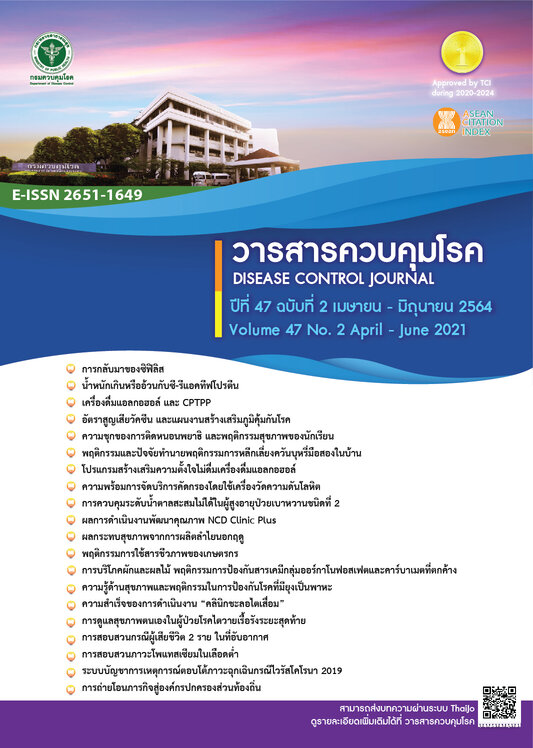Behavior and factors predicting secondhand smoke avoidance behavior at home among junior high school students, Mueang district, Chainat province
DOI:
https://doi.org/10.14456/dcj.2021.23Keywords:
ควันบุหรี่มือสอง, พฤติกรรมหลีกเลี่ยงควันบุหรี่มือสอง, นักเรียนชั้นมัธยมศึกษาตอนต้นAbstract
Background and objectives: Secondhand smoke (SHS) exposure is known to affect adolescents’ health and increases the likelihood of becoming new smokers. Secondhand smoke avoidance behavior at home indicates an important practice among adolescents in protecting themselves from SHS exposure. This study aimed to examine secondhand smoke avoidance behavior and factors predicting secondhand smoke avoidance behavior at home among junior high school students, Mueang district, Chainat province. Methods: This study was a cross-sectional study. The samples were 298 junior high school students who had been exposed to SHS at home. Data were collected using a questionnaire and were analyzed using descriptive statistics and Multiple Linear Regression. Results: The result showed that the mean of secondhand smoke avoidance behavior score at home was 23.14 (SD=3.71), at the medium level. Family support (β=0.508, p<0.001), perceived self-efficacy of secondhand smoke avoidance (β=0.104, p=0.049), and exposure time to SHS (β=0.110, p=0.031) were significantly positively correlated with secondhand smoke avoidance behavior at home. The factors were accounted for 40.00% of secondhand smoke avoidance behavior (R2=0.400, p<0.001). Suggestions: The relevant agencies should encourage perceived self-efficacy of secondhand smoke avoidance in adolescents and promote family support at home in order to increase secondhand smoke avoidance behavior among adolescents
Downloads
References
Minnesota Department of Health, Tobacco Prevention and Control. Health Risks of Secondhand Smoke [Internet]. 2017 [cited 2018 Jan 17]. Available from: https://www.health.state.mn.us/communities/tobacco/secondhand/index.html
Enstrom JE, Kabat GC. Environmental tobacco smoke and tobacco related mortality in a prospective study of Californians. BMJ. 2003;326(7398):1960-98.
Centers for Disease Control and Prevention. Secondhand smoke (SHS) facts: smoking & tobacco use [Internet]. 2018 [cited 2018 Jan 17]. Available from: https://www.cdc.gov/tobacco/data_statistics/fact_sheets/secondhand_smoke/health_effects/index.htm
Gharaibeh H, Haddad L, Alzyoud S, El-Shahawy O, Baker NA, Umlauf M. Knowledge, attitudes, and behavior in avoiding secondhand smoke exposure among non-smoking employed women with higher education in Jordan. Int J Environ Res Public health. 2011;8(11):4207-19.
Wu TD, Eakin MN, Rand CS, Brigham EP, Diette GB, Hansel NN, et al. In-home secondhand smoke exposure among urban children with asthma contrasting households with and without residential smokers. Journal of Public Health Management and Practice. 2019;25(2):7-16.
Precioso J, Rocha V, Sousa I, Araújo AC, Machado JC, Antunes H. Prevalence of Portuguese children exposed to secondhand smoke at home and in the car. Acta Med Port. 2019;32(7-8):499-504.
Health Information System Development Office. Thai public health survey by physical examination report: Children’ s Health [Internet]. 2020 [cited 2020 Sep 20]. Available from: https://www.hiso.or.th/hiso/picture/reportHealth/report/thai2014kid.pdf (in Thai)
World Health Organization. WHO framework convention on tobacco control. Geneva: World Health Organization; 2003.
Tobacco Control Research and Knowledge Management Center. Secondhand smoke literature review. Bangkok: Tobacco Control Research and Knowledge Management Center Mahidol University; 2018. (in Thai)
World Health Organization. Global Youth Tobacco Survey Thailand 2015. Geneva: World Health Organization; 2015.
Phetpoom C. Health behavior, concepts, theories and applications. Phitsanulok: Nareasuan University; 2017. (in Thai)
Suthum K, Boonshuyar CH, Pacheun O. Preventive Behaviors on Secondhand Smoke among Secondary School Pupils, Ratchaburi Province. Journal of Health Education. 2019;42(2):172-83. (in Thai)
Schwartz J, Graham RB, Richardson CG, Okoli CT, Struik LL, Bottorff JL. An examination of exposure and avoidance behavior related to second-hand cigarette smoke among adolescent girls in Canada. BMC Public Health. 2014;14(468):1-9.
Lee JY, Ahn H, Lee H. Factors affecting secondhand smoke avoidance behavior of Vietnamese adolescents. Int J Environ Res Public Health. 2018;15(8):52-63.
World Health Organization. Child and Adolescent Health and Development. Paper presented at the Child and adolescent health and development: progress report 2006, France: World Health Organization; 2006.
Ua-Kit N, Pensri L. Utilization of the PRECEDE MODEL in Health Promotion. Thai Red Cross Nursing Journal. 2019;12(1):38-48. (in Thai)
Wayne WD. Biostatistics: A foundation of analysis in the health sciences. 6th ed. New Jersey, John Wiley & Sons Inc; 1995.
Ketsing W. Mean and Interpret. Journal of Educational Research. 1987;18(3):8-11. (in Thai)
Nurapak A, Sombhopcharoen M, Temsirikunchai L, Kengganpanich M. Factors correlated with assertive behavior when exposed to secondhand smoke in secondary school students in Bangkok metropolitan. Journal of Boromarajonani College of Nursing, Bangkok. 2014;30(2):37-47. (in Thai)
Li MF, Wang RH. Factors related to avoidance of environmental tobacco smoke among adolescents in Southern Taiwan. J Nurs Res. 2006;14(2):103-12.
Kaiyawan Y. Statistics for Research. Bangkok: Sue-some Bangkok Publisher; 2003. (in Thai)
Hamilton DF, Ghert M, Simpson AHRW. Interpreting regression models in clinical outcome studies. Bone Joint Res. 2015;4(9):152-3.
Huang HL, Yen YY, Lin PL, Chiu CH, Hsu CC, Chen T, et al. Household secondhand smoke exposure of elementary schoolchildren in Southern Taiwan and factors associated with their confidence in avoiding exposure: a cross-sectional study. BMC Public Health. 2012;12(40):1471-2458.
Fongkerd S, Pookitsana S, Tangjirawattana M, Tantalanukul S. Factors Influencing Health Promoting Behaviors of Thai Adolescents. NAN PHO Journal of Public Health. 2017;27(special):196-209. (in Thai)
Downloads
Published
How to Cite
Issue
Section
License
Articles published in the Disease Control Journal are considered as academic work, research or analysis of the personal opinion of the authors, not the opinion of the Thailand Department of Disease Control or editorial team. The authors must be responsible for their articles.






